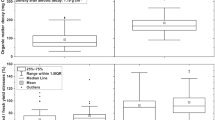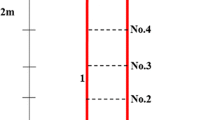Abstract
Purpose
Fine sediments are usually collected in situ and air-dried for adsorption experiments, which may lead to particle aggregation and thus have a significant effect on phosphorus (P) adsorption under dynamic conditions. The main purpose of this study was to investigate the changes of aggregates due to drying with shear stress and the effects on the adsorption of P onto air-dried sediments under different shear rates after re-wetting.
Materials and methods
Sediment samples were collected from an alluvial river. Fine wet sediments (<31 μm) were wet-sieved and air-dried, and some air-dried sediments were further sonicated and served as the control. The grain size distribution of the three sediment samples (wet, dried, and sonicated) was measured to evaluate the particle aggregation level. The P sorption capacity of wet and dried sediments was determined by batch equilibrium experiments. The change of aggregate size with shear stress was investigated for dried and sonicated sediments. Sorption equilibrium experiments were performed to investigate the effect of shear stress on the P sorption with and without change of particle aggregation level, respectively.
Results and discussion
Fine particles agglomerated into larger aggregates during the drying process, resulting in a significant increase in the aggregate size. The sorption capacity was lower in aggregated sediment than in original wet sediment. Aggregate size in dried sediment decreased with the increase of shear rate, leading to an increase in the surface area and available adsorption sites, whereas the particle size of sonicated sediment was hardly affected. Accordingly, the P sorption amount of dried sediment increased with increasing shear rate, whereas that of sonicated sediment showed no significant change with shear rate after all sediments were suspended. There was a significant curvilinear correlation between aggregate size and P sorption amount for dried sediments, thus indicating that the P sorption amount increased significantly with decreasing aggregate size.
Conclusions
Sediment aggregation is an important factor affecting P adsorption besides the amount of suspended sediments and the exchange between suspended and bed sediments under dynamic conditions. The P equilibrium adsorption amount increases with shear stress for air-dried sediment. The effect of particle aggregation on the amount of P sorbed onto sediments should not be ignored, and thus, more attention should be paid to the pretreatment of sediment samples in the sorption experiments under dynamic conditions.








Similar content being viewed by others
References
Aldous A, McCormick P, Ferguson C, Graham S, Craft C (2005) Hydrologic regime controls soil phosphorus fluxes in restoration and undisturbed wetlands. Restore Ecol 13:341–347
An WC, Li XM (2009) Phosphate adsorption characteristics at the sediment-water interface and phosphorus fractions in Nansi Lake, China, and its main inflow rivers. Environ Monit Assess 148:173–184
Baldwin DS (1996) Effects of exposure to air and subsequent drying on the phosphate sorption characteristics of sediments from a eutrophic reservoir. Limnol Oceanogr 41:1725–1732
Baldwin DS, Mitchell AM (2000a) The effects of drying and re-flooding on the sediment and soil nutrient dynamics of lowland river-floodplain systems: a synthesis. Regul River 16:457–467
Baldwin DS, Mitchell AM, Rees GN (2000b) The effects of in situ drying on sediment-phosphate interactions in sediments from an old wetland. Hydrobiologia 431:3–12
Barrow NJ (2008) The description of sorption curves. Eur J Soil Sci 59:900–910
Barrow NJ, Shaw TC (1979) Effects of solution: soil ratio and vigour of shaking on the rate of phosphate adsorption by soil. Eur J Soil Sci 30:67–76
Berhane I, Sternberg RW, Kineke GC, Milligan TG, Kranck K (1997) The variability of suspended aggregates on the Amazon. Cont Shelf Res 17:267–285
Biggs CA, Lant PA (2000) Activated sludge flocculation: on-line determination of floc size and the effect of shear. Water Res 34:2542–2550
Coops H, Beklioglu M, Crisman TL (2003) The role of water-level fluctuations in shallow lake ecosystems—workshop conclusions. Hydrobiologia 506:23–27
Dieter D, Herzog C, Hupfer M (2015) Effects of drying on phosphorus uptake in re-flooded lake sediments. Environ Sci Pollut Res 22:17065–17081
Djati Utomo H, Hunter KA (2010) Particle concentration effect: adsorption of divalent metal ions on coffee grounds. Bioresour Technol 101:1482–1486
Fan Q, Tanaka K, Sakaguchi A, Kondo H, Watanabe N, Takahashi Y (2014) Factors controlling radiocesium distribution in river sediments: field and laboratory studies after the Fukushima Dai-ichi nuclear power plant accident. Appl Geochem 48:93–103
Forstner U (1979) Sources and sediment associations of heavy metals in polluted coastal regions. Phys Chem Earth 11:849–866
Forstner U, Westrich B (2005) BMBF coordinated research project SEDYMO (2002–2006)—sediment dynamics and pollutant mobility in river basins. J Soils Sediments 5:134–138
Havens KE, Steinman AD (2015) Ecological responses of a large shallow lake (Okeechobee, Florida) to climate change and potential future hydrologic regimes. Environ Manag 55:763–775
Helmy AK, Ferreiro EA, de Bussetti SG (2000) Effect of particle association on 2,2′-bipyridyl adsorption onto kaolinite. J Colloid Interf Sci 225:398–402
Hillel D, Hatfield JL (2005) Encyclopedia of soils in the environment. Elsevier, Amsterdam
Horowitz AJ, Elrick KA (1987) The relation of stream sediment surface area, grain size and composition to trace element chemistry. Appl Geochem 2:437–451
Huang S-l, Ng C-o, Guo Q-z (2007) Experimental investigation of the effect of flow turbulence and sediment transport patterns on the adsorption of cadmium ions onto sediment particles. J Environ Sci-China 19:696–703
Huang L, Fu L, Jin C, Gielen G, Lin X, Wang H, Zhang Y (2011) Effect of temperature on phosphorus sorption to sediments from shallow eutrophic lakes. Ecol Eng 37:1515–1522
Kerr JG, Burford M, Olley J, Udy J (2010) The effects of drying on phosphorus sorption and speciation in subtropical river sediments. Mar Freshw Res 61:928–935
Kinsman-Costello LE, O'Brien J, Hamilton SK (2014) Re-flooding a historically drained wetland leads to rapid sediment phosphorus release. Ecosystems 17:641–656
Kondo S, Ishikawa T, Abe I (1991) Science of adsorption. Maruzen, Tokyo
Lai DYF, Lam KC (2009) Phosphorus sorption by sediments in a subtropical constructed wetland receiving stormwater runoff. Ecol Eng 35:735–743
Land LE, Kolker AS, Gambrell RP (2012) Biotic and abiotic controls on sediment aggregation and consolidation: implications for geochemical fluxes and coastal restoration. Mar Environ Res 79:100–110
Li T, Wang D, Zhang B, Liu H, Tang H (2006) Characterization of the phosphate adsorption and morphology of sediment particles under simulative disturbing conditions. J Hazard Mater 137:1624–1630
Li Z, Tang H, Xiao Y, Zhao H, Li Q, Ji F (2016) Factors influencing phosphorus adsorption onto sediment in a dynamic environment. J Hydro-environ Res 10:1–11
Manning AJ, Dyer KR (1999) A laboratory examination of floc characteristics with regard to turbulent shearing. Mar Geol 160:147–170
Schönbrunner IM, Preiner S, Hein T (2012) Impact of drying and re-flooding of sediment on phosphorus dynamics of river-floodplain systems. Sci Total Environ 432:329–337
Serra T, Colomer J, Logan BE (2008) Efficiency of different shear devices on flocculation. Water Res 42:1113–1121
Spicer PT, Keller W, Pratsinis SE (1996) The effect of impeller type on floc size and structure during shear-induced flocculation. J Colloid Interf Sci 184:112–122
Stone M, Mudroch A (1989) The effect of particle size, chemistry and mineralogy of river sediments on phosphate adsorption. Environ Technol Lett 10:501–510
Stone M, Mulamoottil G, Logan L (1995) Grain size distribution effects on phosphate sorption by fluvial sediment: implications for modelling sediment-phosphate transport. Hydrolog Sci J 40:67–81
Tombácz E, Filipcsei G, Szekeres M, Gingl Z (1999) Particle aggregation in complex aquatic systems. Colloid Surface A 151:233–244
Vo NXQ, Kang H (2013) Regulation of soil enzyme activities in constructed wetlands under a short-term drying period. Chem Ecol 29:146–165
Wang S, Jin X, Bu Q, Zhou X, Wu F (2006) Effects of particle size, organic matter and ionic strength on the phosphate sorption in different trophic lake sediments. J Hazard Mater 128:95–105
Wang QY, Liu JS, Wang Y, Yu HW (2015) Accumulations of copper in apple orchard soils: distribution and availability in soil aggregate fractions. J Soils Sediments 15:1075–1082
Xia B, Zhang Q, Yang J, Jiang C (2012) Experimental investigation of the effect of flow turbulence on the adsorption of phosphorus onto sediment particles. Appl Mech Mater 212-213:299–306
Xiao R, Zhang MX, Yao XY, Ma ZW, Yu FH, Bai JH (2016) Heavy metal distribution in different soil aggregate size classes from restored brackish marsh, oil exploitation zone, and tidal mud flat of the Yellow River Delta. J Soils Sediments 16:821–830
Xu WH, Li XD, Wai O, Huang WL, Yan W (2015) Remobilization of trace metals from contaminated marine sediment in a simulated dynamic environment. Environ Sci Pollut Res 22:19905–19911
Zhou AM, Tang HX, Wang DS (2005) Phosphorus adsorption on natural sediments: modeling and effects of pH and sediment composition. Water Res 39:1245–1254
Acknowledgements
This work was supported by the National Natural Science Foundation of China (Nos. 51239003, 51509073, and 51409085), and special thanks for the help of Huaihe River Basin Water Resource Protection Bureau.
Author information
Authors and Affiliations
Corresponding author
Additional information
Responsible editor: Ian Foster
Rights and permissions
About this article
Cite this article
Tang, H., Li, Q., Yuan, S. et al. Effect of aggregation on the adsorption of phosphorus onto air-dried sediment in contrasting shear flow conditions. J Soils Sediments 17, 2177–2186 (2017). https://doi.org/10.1007/s11368-017-1681-9
Received:
Accepted:
Published:
Issue Date:
DOI: https://doi.org/10.1007/s11368-017-1681-9




